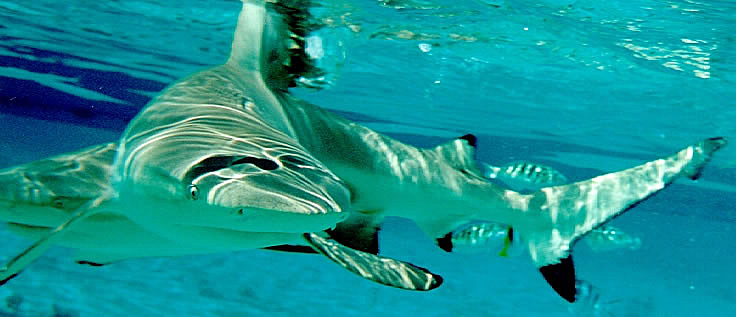 The bull shark is very, very dangerous. Some experts consider this shark to be the most dangerous in the world, even surpassing the Great White Shark. Surprisingly few people have even heard of it. It has a number of different names both in Australia and around the world and people think they are a different species of shark. In Australia this species is also known as Freshwater Whalers, Swan River Whaler and River Whaler. In Africa it is called the Zambezi Shark. In Central America it often goes by the name of Lake Nicaragua Shark. It has also been known as River Shark, Cub Shark, Van Rooyen's Shark, Slipway Grey Shark, Square Nose Shark and more..... This shark is often mistaken for a Bronze Whaler in Australia.It is a heavy bodied shark with a short nose and a medium sized second dorsal fin. It has broad, serrated triangular upper teeth. It has very powerful jaws. Grows to about 350cm. Studies of this shark believe it lives for about 14 years and prefers to breed in the mouth of rivers. It has a broad diet and will eat almost anything. It has been noted by researchers that it does seem to have a preference for eating baby Sandbar Sharks. This shark has been found 4000 km from the sea in the Amazon River. It has penetrated right down the Mississippi River in the USA. It can live in almost any water including water with a high salt content as in St. Lucia Lake in South Africa. It seems to prefer rivers and inlets with shallow water and is not often reported far out at sea. However I have heard of a few sitings of these sharks out in the deep ocean in the same areas as Tiger Sharks.
The bull shark is very, very dangerous. Some experts consider this shark to be the most dangerous in the world, even surpassing the Great White Shark. Surprisingly few people have even heard of it. It has a number of different names both in Australia and around the world and people think they are a different species of shark. In Australia this species is also known as Freshwater Whalers, Swan River Whaler and River Whaler. In Africa it is called the Zambezi Shark. In Central America it often goes by the name of Lake Nicaragua Shark. It has also been known as River Shark, Cub Shark, Van Rooyen's Shark, Slipway Grey Shark, Square Nose Shark and more..... This shark is often mistaken for a Bronze Whaler in Australia.It is a heavy bodied shark with a short nose and a medium sized second dorsal fin. It has broad, serrated triangular upper teeth. It has very powerful jaws. Grows to about 350cm. Studies of this shark believe it lives for about 14 years and prefers to breed in the mouth of rivers. It has a broad diet and will eat almost anything. It has been noted by researchers that it does seem to have a preference for eating baby Sandbar Sharks. This shark has been found 4000 km from the sea in the Amazon River. It has penetrated right down the Mississippi River in the USA. It can live in almost any water including water with a high salt content as in St. Lucia Lake in South Africa. It seems to prefer rivers and inlets with shallow water and is not often reported far out at sea. However I have heard of a few sitings of these sharks out in the deep ocean in the same areas as Tiger Sharks.
The bull shark has a short snout that is wider than it is long (hence its name). Its belly is off-white, its top surface is gray, and the eyes are small. The first dorsal fin is much longer and more pointed than the second dorsal fin. A pup's fins have black tips, but these marking fade in the adults. The females are larger than the males. The bull shark is also know as the cub, Ganges, Nicaragua, river, Swan River Whaler, Zambezi, shovelnose, slipway grey, square-nose, and Van Rooyen's shark. TEETH Bull shark teeth are triangular, serrated (saw-edged), and very sharp. The teeth are located in rows which rotate into use as needed. The first two rows are used in obtaining prey, the other rows rotate into place as they are needed. As teeth are lost, broken, or worn down, they are replaced by new teeth that rotate into place.
DIET AND FEEDING HABITS
HABITAT AND DISTRIBUTION
REPRODUCTION
MIGRATION
POPULATION COUNT |